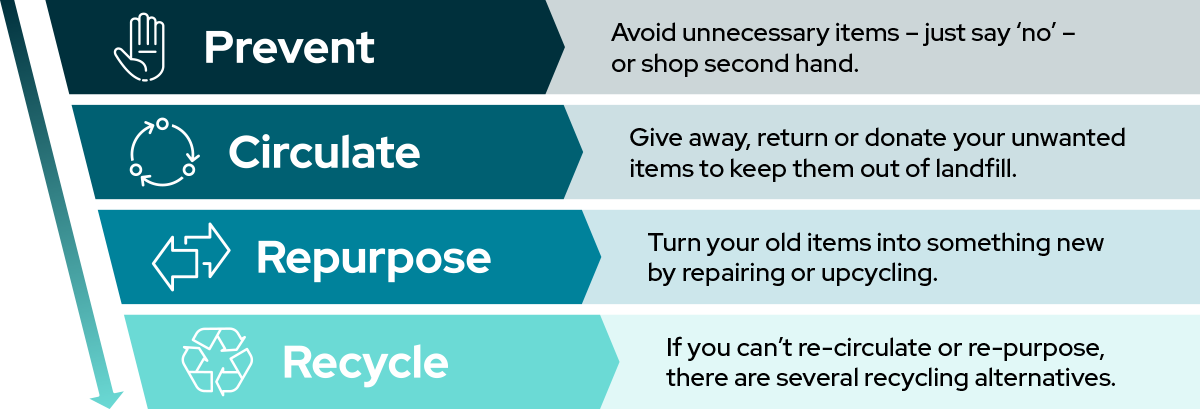Clothing and textile waste
Australians throw out approximately 300 kilotonnes (kt) of clothing every year, with the majority of unwanted items ending up in landfill. Only a small fraction is recovered and resold through second hand and charity shops, domestic violence support and animal shelters.
How can you reduce clothing and textile waste?

1. Prevent
Avoid unnecessary items – just say ‘no’ – or shop second hand. Think, ‘Do I really need this item?’
Tips:
- check your wardrobe – find a trusty favourite, something you have forgotten about, upcycle or mix and match your items for a new look
- avoid impulse buying – unfollow social media accounts, newsletters and apps that make you want to shop more
- set spending limits – sites such as Temu and Shein can add up fast if you’re a regular shopper.
Buy second hand:
Mend or upcycle your clothes:
- learn how to mend or alter your clothes to create something new or longer lasting
- Northern Rivers Reuse and Repair Trail features specialists in fixing your stuff.
If you must buy new:
- choose high-quality clothing – these items will usually last longer
- shop local – buy Australian made, or better yet, Tweed local fashion labels
- choose natural fibres – cotton, linen, wool, silk, hemp or bamboo.
Did you know: Synthetic materials such as polyester, nylon and elastane are made from fossil fuels.
| By extending the life of your clothes by 9 months, carbon, waste and water footprints could be reduced by 20–30% each item. |
2. Circulate
Give away, return or donate your unwanted items to keep them out of landfill.
Sell your unwanted items:
Donate or gift your items:
- donate only clean and good quality clothes to local Tweed op-shops
- give away to family or friends
- use Givit to match your donation to someone in need from domestic violence
- donate to crisis appeals or emergency relief.
3. Repurpose
Turn your old items into something new by repairing or upcycling.
Repair or upcycle:
- turn your clothes into serviettes, handkerchiefs, scrunchies or cleaning cloths/rags
- wrap gifts in fabric
- keep fabric scraps for patching or repairing clothes.
Donate fabric:
- Boomerang Bags transforms fabric into reusable bags
- Days for Girls makes washable pads from cotton or cotton flannel.
- towels, sheets and blankets can be donated to animal shelters, vets, mechanics and painters.
4. Recycle
If you can’t re-circulate or re-purpose your unwanted clothing and textiles, there are several recycling alternatives.
|
2024 update: Tweed Shire Council is investigating textile recycling partners for unwanted clothing that’s not suitable for resale in charity op shops. Stay tuned for more.
|
Retailer recycling programs include:
- H&M, Zara, Uniqlo have drop off programs
- Macpac and Patagonia offer trade-in programs for store credit
- Sheridan stores accept pre-loved sheets and towels of any brand
- post your box of clothes to Upparel who sort clothing for reuse or recycling
- Tread Lightly recycles shoes of various types – you can drop them off at Rebel Sport or Platypus Shoes.
We’re sure there are more! Tell us who else accepts pre-loved shoes and clothing.
Textile waste in the Tweed
How big is the problem?
Textiles includes clothing and shoes, linen and curtains. Carpets and furniture items are often included in textile waste.
This is what research tells us about clothing and textile waste:

Of nearly 200 kt of donations in 2020–21, it’s estimated:
- 107 kt was exported, mostly to developing countries
- 30–45 kt was resold in charity shops
- 35 kt was sent to landfill due to poor quality
- 3 kt used in welfare programs
- 3 kt processed by textile recyclers to rags, felting or raw chemicals.
In the Tweed, the Stotts Creek Resource Recovery Centre received 421 tonnes of unsaleable goods from op-shops during 2022–23. (This included textiles, furniture, fridges, mattresses, crockery and other items.) Consultation with charity shops indicates this is only a small percentage of textile waste in the Tweed.
How textile waste impacts the environment
Textile waste represents more than just a rapidly growing landfill problem. Clothing waste can also impact the environment through:
- water use: it takes 3,781 litres of water to make 1 pair of jeans
- greenhouse gas emissions: the textiles sector is responsible for 8% of global emissions every year
- fossil fuels and plastic: 60% of all clothes are made from plastics (synthetic fibres such as polyester, acrylic and nylon)
- microfibres: every year a half a million tons of plastic microfibers are dumped into the ocean, the equivalent of 50 billion plastic bottles.
- fast fashion is a contributor: Australians purchase 60% more clothing than they did 15 years ago, however we only wear between 33 to 40% of our wardrobes!
But while these are big numbers, if we simply extended the life of our clothing by a year, we could cut these numbers by a third and save money too!
Towards Zero Waste Strategy
This is an action of the Tweed Shire Council Towards Zero Waste Strategy, Action 3.2f ‘Investigate options for textile recovery’. Find out more.